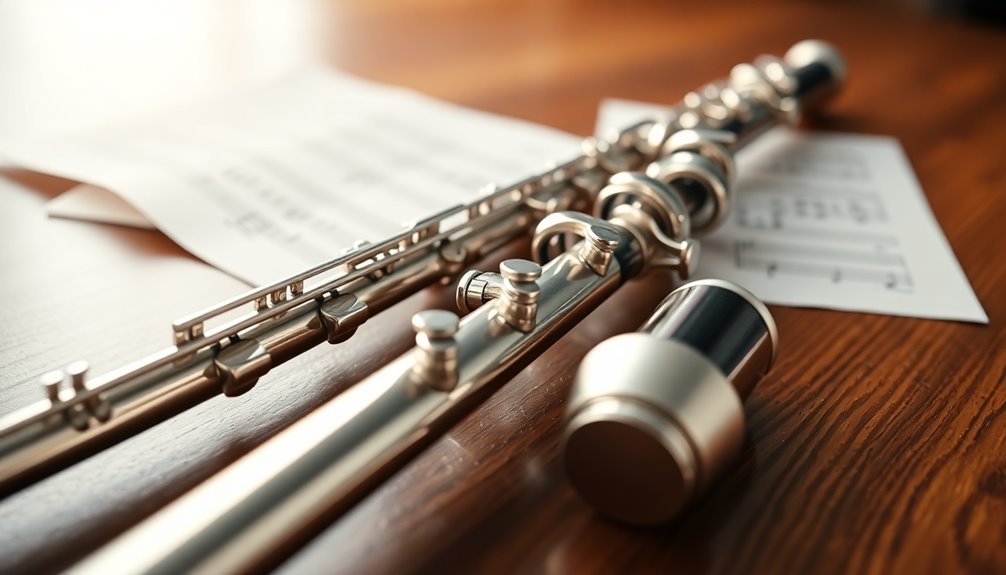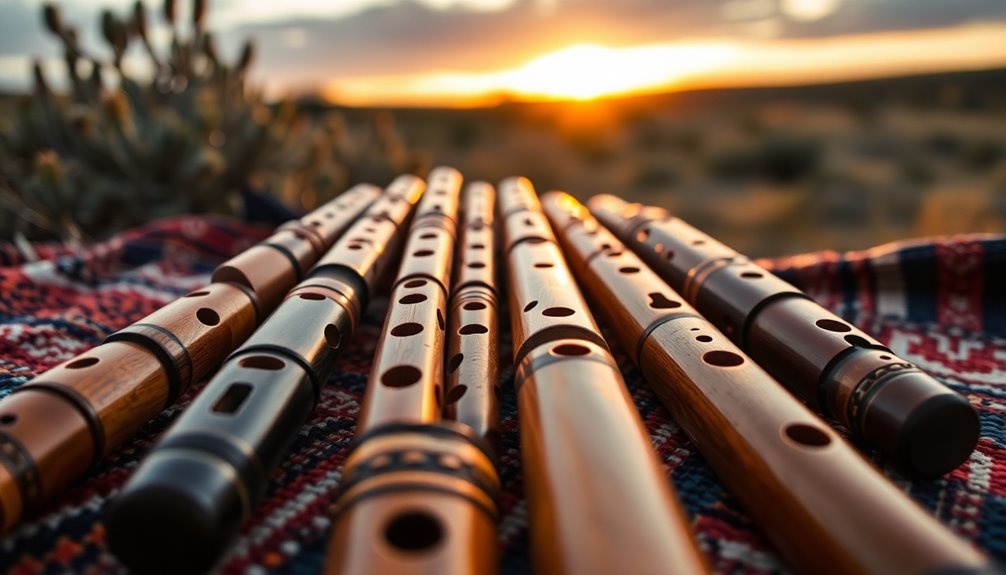If you're starting your journey with the flute, knowing the types can really help. The concert flute is versatile and used in orchestras, while the piccolo, being smaller, plays an octave higher and has a bright sound. The alto flute offers a warm tone and suits various music styles, whereas the bass flute provides rich tones ideal for solos. Don't forget the Native American flute, with its expressive qualities tied to nature and tradition. Understanding these options will guide your choice, and there's so much more to discover about each type to help you on your musical path.
Key Takeaways
- Concert flutes are versatile and widely used in orchestras, known for their rich timbre and expressive capabilities.
- Piccolos are smaller and produce a bright sound, tuned an octave higher than concert flutes, making them ideal for higher melodies.
- Alto flutes offer a warm, mellow tone and are tuned in the key of G, suitable for various musical genres.
- Bass flutes play an octave lower than standard flutes, providing rich tones for both solo and orchestral performances.
- Native American flutes are crafted from wood or bamboo, known for their soothing sounds and deep cultural significance in Indigenous traditions.
Concert Flute

The concert flute, often seen at the forefront of orchestras and chamber music ensembles, is a versatile instrument that appeals to both beginner and advanced players alike. With its rich history dating back to the 17th century, the concert flute has evolved considerably, making it a staple in various musical genres.
You'll find that understanding its history enhances your appreciation for the instrument and its role in the world of music.
When you start exploring concert flute techniques, you'll discover a range of styles and skills that can be developed. From breath control to finger agility, mastering these techniques allows you to express yourself more fully.
The concert flute's unique timbre and expressive capabilities give you the opportunity to connect emotionally with your audience, whether you're performing a solo piece or collaborating with others in an ensemble.
As you explore learning the concert flute, remember that the journey is just as important as the destination. Join local music groups or online communities where you can share experiences, ask questions, and grow alongside fellow flutists.
You'll find camaraderie and support that can fuel your passion for playing. Additionally, investing in a quality instrument, like those from professional flute brands, can greatly enhance your playing experience and overall sound quality.
Ultimately, the concert flute is more than just an instrument; it's a gateway to a vibrant community of musicians. By embracing its history and mastering its techniques, you're not only honing your skills but also becoming part of a rich tradition that spans centuries.
Piccolo

Often considered the smaller sibling of the concert flute, the piccolo packs a powerful punch with its bright, piercing sound. This instrument, typically about 32 centimeters long, is tuned an octave higher than the concert flute, allowing it to cut through orchestral textures with ease.
The piccolo has a rich history, dating back to the early 18th century. Originally made from wood, piccolos evolved into metal instruments by the 19th century, enhancing their durability and projection. Today, you'll find a variety of materials used, from silver to plastic, each offering different tonal qualities.
When you start learning piccolo techniques, you'll notice that breath control is essential. The instrument requires precise air support to reach those high notes without straining your voice.
Additionally, mastering fingerings can be tricky due to the instrument's small size and compact keywork, but with practice, your dexterity will improve.
Incorporating dynamics and articulation into your playing can make a significant difference. Experiment with staccato and legato passages to explore the full range of expression the piccolo offers.
Joining a band or orchestra can also provide a sense of belonging, as you'll collaborate with other musicians who share your passion for this unique instrument. The piccolo's unique timbre enhances the overall orchestral sound, making it a vital component in many compositions.
Alto Flute

Alto flutes offer a unique and rich sound that sets them apart from their smaller counterparts. If you're looking to explore a different musical dimension, the alto flute could be your perfect match. This instrument is larger than the standard flute and plays in the key of G, which gives it a warm, mellow tone that's alluring and soothing.
When you start playing the alto flute, you'll discover a range of alto flute techniques that enhance your playing experience. You might find yourself experimenting with vibrato, breath control, and different fingerings that can create expressive nuances. The larger size may initially feel challenging, but with practice, you'll gain confidence and develop a deeper connection to your music.
The alto flute repertoire is diverse, spanning various genres and styles. You'll find beautiful solos, chamber pieces, and orchestral works that showcase the instrument's rich timbre. From classical compositions to contemporary pieces, there's something for everyone.
Engaging with this repertoire not only enhances your technical skills but also connects you with a community of fellow musicians who appreciate the depth of sound that the alto flute brings. Additionally, understanding key configurations like offset G and split E can greatly improve your playing experience and comfort.
As you explore this wonderful instrument, remember that every note you play helps you belong to a larger musical family. Embrace the journey, and let the alto flute's enchanting voice inspire you to create and connect with others.
Bass Flute

While many flutists are familiar with the standard and alto flutes, the bass flute offers a fascinating alternative that deepens the flute family's sonic palette. Characterized by its rich, warm tones, the bass flute is pitched an octave lower than the standard flute, providing a unique foundation in ensemble settings.
If you're considering adding this instrument to your repertoire, you'll discover a range of bass flute techniques that will enhance your playing.
Here are three key aspects to keep in mind:
- Expressive Range: The bass flute's lower register allows for a more profound emotional expression, making it ideal for both solo performances and orchestral pieces.
- Diverse Repertoire: You'll find an exciting bass flute repertoire that spans various genres, from classical masterpieces to contemporary works. Composers have increasingly embraced the bass flute, creating pieces that showcase its unique sound.
- Techniques to Master: Techniques like flutter tonguing, harmonics, and multiphonics can elevate your playing, helping you explore the instrument's full capabilities.
Additionally, many models feature high-quality materials that enhance tonal quality and durability, making them a worthwhile investment for any musician.
As you explore the world of the bass flute, you'll not only expand your musical skills but also join a community of passionate musicians who appreciate its beauty.
Embrace the journey and enjoy the deep, resonant tones that this remarkable instrument brings to life!
Native American Flute

As you explore the various flutes, the Native American flute stands out with its distinct cultural heritage and hauntingly beautiful sound. This flute has deep cultural significance, often linked to storytelling, rituals, and connection with nature. Each note you play might evoke a sense of belonging, drawing you closer to the traditions and histories of Indigenous peoples.
Crafted traditionally from wood or bamboo, the Native American flute features a simple design that belies its expressive potential. You'll find that the playing techniques are quite accessible, making it a perfect choice for beginners. With just a few breaths, you can create soothing melodies that resonate with the spirit of the land.
To start playing, position the flute horizontally and use your fingers to cover the holes. You'll discover that the sound is produced through a unique embouchure, where you blow gently across the flute's mouthpiece. Experimenting with breath control allows you to explore varying dynamics and emotional expressions. Additionally, the sound quality of bamboo flutes can significantly enhance your musical experience, offering a richness that complements the Native American flute's enchanting tones.
As you practice, you may also choose to incorporate ornamentation, adding personal flair to your music. Connecting with the Native American flute isn't just about learning an instrument; it's a journey into a rich cultural tapestry.
Frequently Asked Questions
What Is the Best Flute for a Complete Beginner?
If you're starting your flute journey, you'll want the best beginner flutes that are easy to play and affordable.
Brands like Yamaha and Gemeinhardt are great choices, offering quality instruments that won't break the bank.
Look for a closed-hole flute, as it simplifies learning.
Remember, investing in a reliable flute will make your practice enjoyable and help you connect with others in the music community.
Immerse yourself and start making beautiful sounds!
How Do I Choose the Right Flute Size?
Choosing the right flute size is like picking the perfect pair of jeans; it's all about comfort!
First, check the flute measurements, as they vary for different players. If you're a beginner, a standard flute might suit you best, but be mindful of your hand span and overall comfort.
Trying out a few sizes can help you find the one that feels just right, allowing you to play with ease and confidence.
Can I Play Different Flute Types Interchangeably?
Yes, you can play different flute types interchangeably, but you'll notice some sound differences.
Each flute has its own unique character, which can affect your music's versatility. For instance, the tone of a concert flute differs from that of a piccolo or alto flute.
While switching between them can enhance your skills and broaden your repertoire, it might take some time to adapt your technique to each instrument's specific nuances.
Enjoy the journey!
What Maintenance Do Flutes Require?
Imagine you've just finished a beautiful performance and want to keep your flute in top shape.
Maintaining your flute involves regular cleaning techniques, such as using a soft cloth to wipe down the exterior after each use.
Don't forget about pad care; keeping the pads dry helps prevent moisture damage.
How Much Should I Expect to Spend on a Flute?
When you're considering how much to spend on a flute, remember that cost considerations vary widely.
You might spend anywhere from $100 for a student model to over $3,000 for professional ones.
Quality factors like material, brand, and craftsmanship play significant roles in pricing.
It's smart to balance your budget with your needs, ensuring you find an instrument that feels right for you and supports your musical journey.
Happy playing!
Conclusion
In conclusion, exploring different flute types opens a world of musical possibilities. Whether you're drawn to the bright notes of the concert flute or the earthy tones of the Native American flute, each instrument offers a unique voice. Remember, "Variety is the spice of life." So, don't hesitate to experiment with these flutes and find the one that resonates with you. Embrace the journey, and let your musical expression flourish as you discover the beauty of each flute type.






